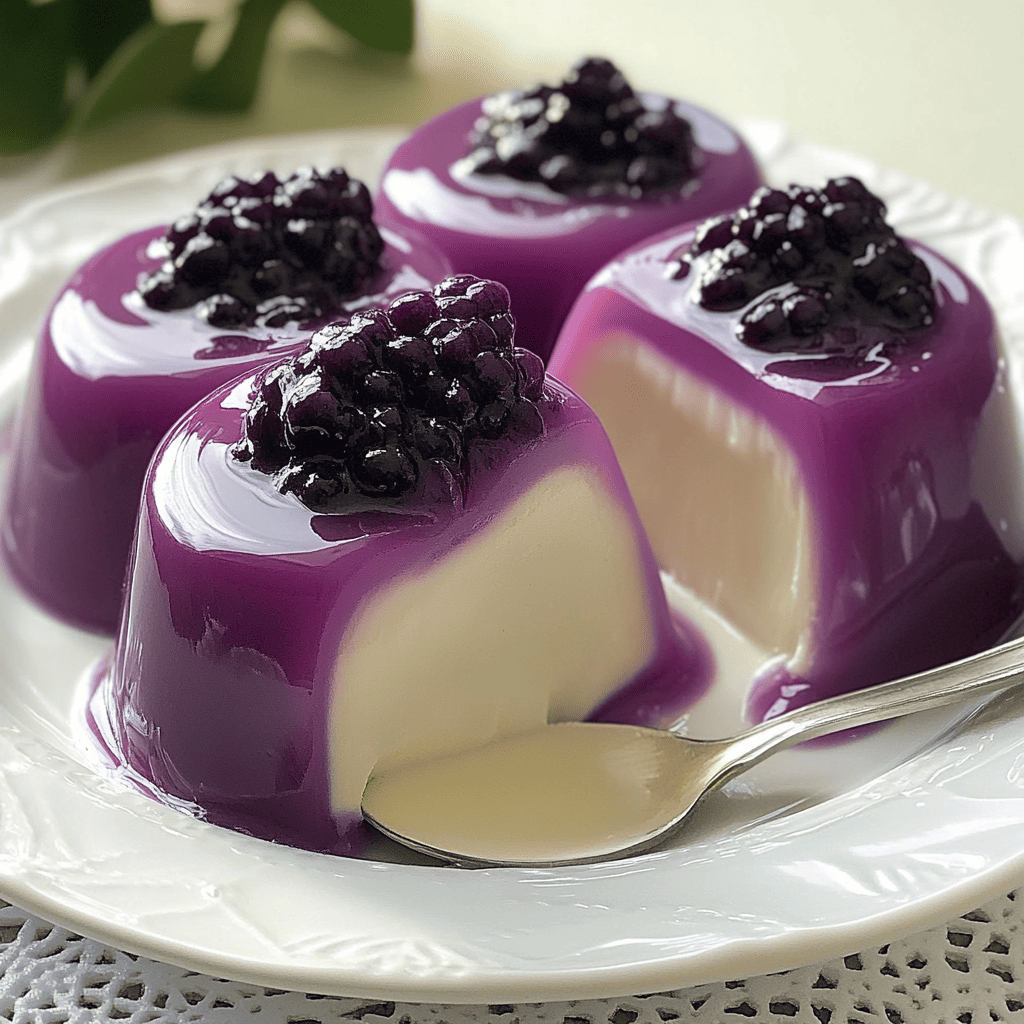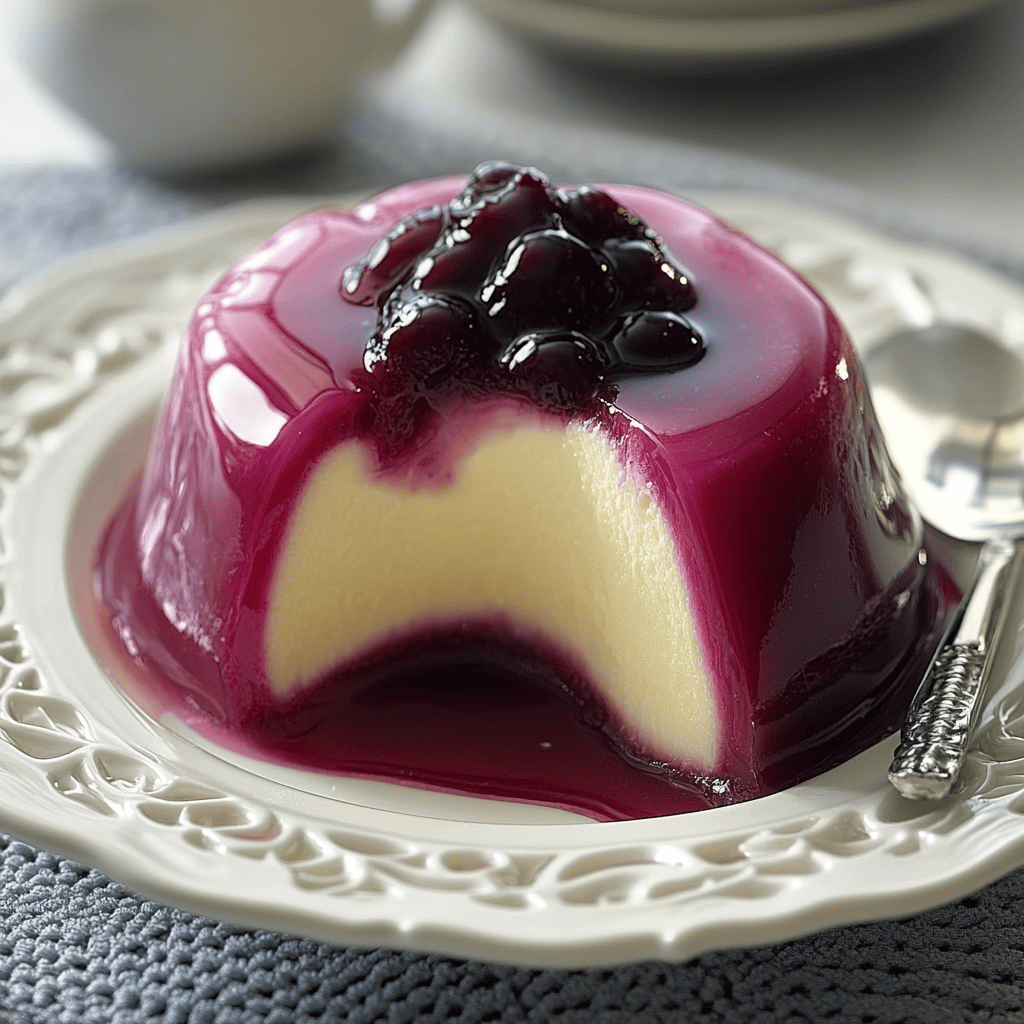Filled Gelatin
Introduction
Filled gelatin is a visually appealing and surprisingly versatile dessert that combines the lightness and shine of flavored gelatin with the creaminess and smoothness of a sweet inner layer. Ideal for those seeking a refreshing and elegant alternative, this dessert is composed of two complementary textures: a firm, creamy white cream base, topped with a translucent gelatin that adds color and flavor. Its ease of preparation, the playfulness of temperatures, and the possibility of customizing flavors make filled gelatin a perfect choice for family gatherings, children’s parties, dessert buffets, and formal celebrations.
Filled gelatin is an iconic dessert of creative pastry, especially in Latin America, where gelatin has transcended its basic form to become a canvas of colors, flavors, and textures. This sweet treat stands out not only for its vibrant presentation but also for the surprise hidden inside: layers of cream, fruit pieces, flan, or even dulce de leche, which contrast with the freshness and lightness of the gelatin.
A Dessert with History
Gelatin, in its simplest form, has ancient roots, but it wasn’t until the 20th century that it became popular as an affordable and versatile product, thanks to brands like Jell-O and Royal . However, in countries like Mexico, Colombia, and Argentina, chefs and bakers took this ingredient to the next level, experimenting with fillings and techniques to transform it into a sophisticated dessert, ideal for celebrations.
Filled gelatin emerged as a natural evolution of the tradition of layered desserts, such as tres leches or flan , but with a playful and visual touch. Its rise in the 1960s and 1970s coincided with the golden age of home baking, where presentation and innovation were key to family gatherings and social events.
Why is it so special?
- Versatility : It can be fruity, dairy, acidic or sweet, adapting to all types of tastes.
- Visual impact : The contrasts of colors and shapes in molds make it irresistible to the eye.
- Textures : The softness of the gelatin with the creaminess of the filling create a unique experience when tasting it.
Today, filled gelatin remains a symbol of festivity and culinary creativity , reinventing itself with modern techniques while maintaining its traditional essence. From elegant versions with mousse fillings to children’s desserts with gummy candies inside, its legacy lives on in sweet cuisines around the world.

Detailed History
Gelatin, originating in medieval Europe, began as a dish made with bone broth and animal gelatin, reserved for the nobility. In the 19th century, the invention of powdered gelatin by Peter Cooper in 1845 democratized its consumption, allowing for simple home preparations. In Mexico and Latin America, flavored gelatin became popular in the 20th century, becoming a common dessert in homes and at celebrations.
The idea of filling gelatin with creamy layers arose from the fusion of French pastry techniques—which use layers of mousses and creams—and the practicality of industrial gelatin. Towards the 1960s and 1970s, home cooks began to innovate with layered molds, combining fruit gelatin with homemade custards and flans.
In the following decades, the filled gelatin spread into multiple versions: from layers of cream cheese and yogurt to fruit, cookie, and candy encrustations. Today, this dessert, featured on baking blogs and social media, stands out for its aesthetic appeal and simplicity, making it a favorite at children’s parties, dessert buffets, and formal events.
Origins and Evolution
Filled gelatin is a creative dessert that combines the smooth, vibrant texture of gelatin with a surprising filling inside. Its history is linked to the development of gelatin as a culinary ingredient and to innovation in baking.
- Background of gelatin :
- Gelatin has been consumed since ancient times, extracted from animal collagen (skins, bones). In the 19th century, it became popular in Europe and America thanks to industrial processes that transformed it into a dehydrated, easy-to-prepare product (such as the Knox brand in 1890 or Jell-O in 1897).
- In Mexico and other Latin American countries, gelatin was adapted to local flavors, becoming a festive and colorful dessert.
- Birth of filled gelatin :
- The idea of filling gelatin emerged as a way to elevate its presentation, especially at celebrations. It’s believed that in Mexico , during the 1950s and 1960s, pastry chefs experimented with adding fruit, whipped cream, custard, or even flan to the center.
- Another influence may have been “mosaic” gelatin (pieces of colored gelatin in condensed milk), which inspired versions with layers or fillings.
- Regional variations :
- Cream or milk gelatin : In countries like Colombia or Venezuela, it is filled with arequipe (dulce de leche) or pastry cream.
- “Imperial” gelatin : In Mexico, it is sometimes filled with fruit in syrup or yogurt.
- Flan-filled gelatin : A classic combination where the flan is poured into the center of the gelatin before it sets.
Popularization
- In the 1970s and 1980s, filled gelatin became a favorite dessert for children’s parties, weddings, and family gatherings , thanks to its versatility and visual appeal.
- Cookbooks and television programs spread techniques for creating layered fillings or mold designs.
Preparation Techniques
The secret is in the setting time :
- A first layer of gelatin is prepared and allowed to set partially.
- The filling is added (e.g., fruit, cream mixed with unset gelatin).
- It is covered with another layer of liquid gelatin and refrigerated.
Legacy
Today, filled gelatin remains a symbol of Latin American festive pastries , with modern versions including cheesecake, mousse, or even liqueur fillings. Its success lies in the combination of colors, flavors, and textures , proving that gelatin is much more than a simple dessert.

Ingredients and Preparation
Ingredients
For the flavored gelatin:
- 1 sachet (85 g) of grape-flavored powdered gelatin (or the flavor of your choice)
- 500 ml of water (divided into 250 ml for hydrating and 250 ml for dissolving)
For the white cream:
- 1 can (395 g) of condensed milk
- 1 box (200 ml) of heavy cream (whipping cream)
- 200 ml of whole milk (or coconut milk)
- 1 teaspoon (5 g) cornstarch (if using regular milk)
- 1 sachet (7 g) of unflavored gelatin
- 50 ml of water to hydrate the unflavored gelatin
To grease and unmold:
- Lightly butter or spray oil
Step-by-Step Preparation
- Hydrate unflavored gelatin: In a small container, mix 50 ml of cold water with the unflavored gelatin sachet and let it sit for 5 minutes.
- Prepare white cream:
- Heat 200 ml of milk (or coconut milk) with the cornstarch over medium heat, stirring constantly until slightly thickened.
- Remove from heat and add the condensed milk and heavy cream, mixing well.
- Incorporate the hydrated gelatin by heating it briefly (30 seconds) and add it to the mixture, beating with a whisk until smooth.
- Pour cream layer:
- Lightly grease a baking tray or mold measuring approximately 20×20 cm.
- Pour the white cream in an even layer and refrigerate for 2–3 hours, or until completely set.
- Dissolve flavored gelatin:
- Hydrate the flavored gelatin in 250 ml of cold water for 5 minutes.
- Heat the remaining 250 ml in a saucepan without letting it boil.
- Dissolve the hydrated gelatin in the hot water, stirring gently.
- Let the gelatin cool for a few minutes, preventing it from solidifying.
- Pour gelatinous layer:
- Carefully pour the cooled flavored gelatin over the curdled cream.
- Refrigerate again for 2 hours, or until the gelatin is firm.
- Unmold and serve:
- Run a thin knife around the edges of the mold to loosen.
- Place the tray in warm water (just for a second) to make it easier to remove from the mold.
- Invert onto a plate or base and remove the mold.
- Cut into portions and serve cold.
Texture and Flavor
- Texture: The combination of the inner cream and the gelatin creates a contrast between a soft and syrupy layer and a refreshing and gelatinous one .
- Flavor: Sweet and fruity, where the cream base provides milky and softly sweetened notes , while the grape jelly (or other flavor) introduces fruity and slightly acidic touches .
Consumer Context
- It is mainly enjoyed in warm climates , as a refreshing dessert.
- Popular at family reunions, children’s parties, dessert buffets, and formal celebrations .
- Ideal as a light finishing touch after heavy meals.
Visual Aspect
- It has two perfectly defined layers: a white cream and a bright, colorful jelly .
- It can be decorated with fresh fruit, mint leaves or citrus zest to add contrast.
- Its cut into cubes or transparent sheets highlights the duality of textures and colors .
Curiosities
- Filled gelatin is an example of a layering technique , widely used in professional pastry making.
- Themed molds can be used for creative presentations (hearts, stars, etc.).
- Versatile: accepts different flavored jellies and flavored creams (coconut, coffee, white chocolate).
Estimated Nutritional Value (per 100g serving)
(Approximate values, depending on ingredients)
- Calories: 150 – 180 kcal
- Fats: 5 – 8 g
- Carbohydrates: 25 – 30 g
- Sugars: 20 – 25 g
- Protein: 1 – 2 g
- Fiber: <1 g
- Sodium: 50 – 100 mg
Additional Benefits and Interesting Facts
- Hydration: High water content, useful for refreshing.
- Vitamin C: If natural gelatin juice is used (not just powder), it provides antioxidants.
- Adaptability: Light option for diets, regulating sugar and fat.
- Aesthetics: Attractive for presentations and events.
Questions for Reflection
- What other gelatin flavors would you combine with the inner cream?
- Would you prefer to use natural juices or commercial powdered gelatin?
- What type of mold would you use to present this dessert?
- How would you adjust the recipe for a healthier version?
- Would you add any extra toppings or decorations, such as fruits or herbs?

Conclusion
Filled gelatin is a dessert that masterfully blends gelatinous lightness with indulgent creaminess , offering a multisensory experience. Its ease of preparation and versatility of flavors make it an ideal choice for both novice and professional cooks. By combining accessible ingredients and layering techniques, this dessert stands out not only for its visual appeal but also for its ability to refresh and satisfy diverse palates.
In family settings, it becomes the star of children’s parties and gatherings, while at more formal events, thanks to the use of creative molds and sophisticated decorations, it acquires a gourmet touch. Nutritionally, it offers a moderate calorie option, adaptable to healthier versions without losing flavor or texture.
Ultimately, filled gelatin demonstrates that the combination of two layers with contrasting characteristics can result in a balanced, versatile, and aesthetically striking dessert. Its preparation can serve as a starting point for culinary experimentation, inviting innovation with flavors, colors, and presentations, becoming an edible canvas that surprises and delights with every bite.

